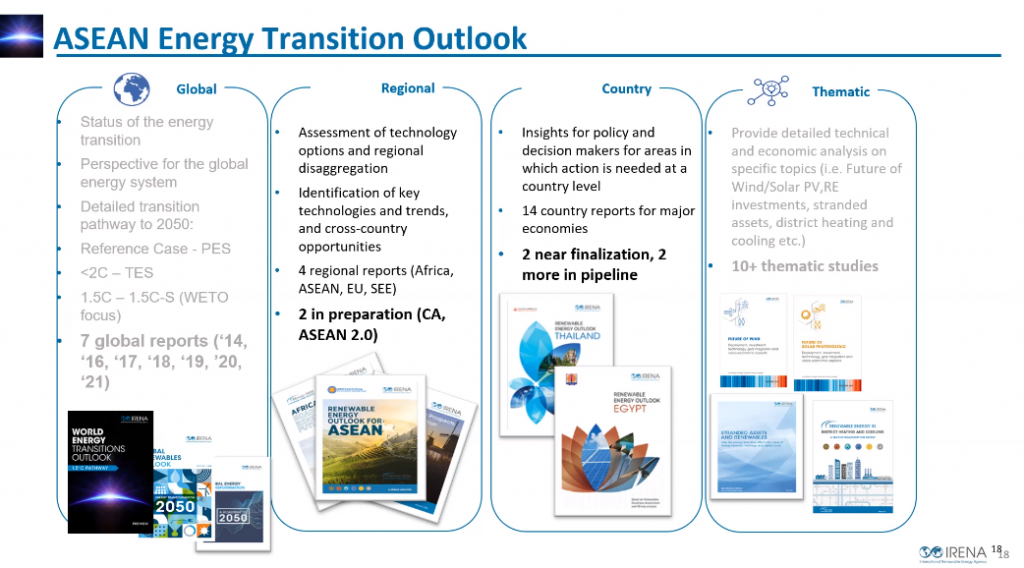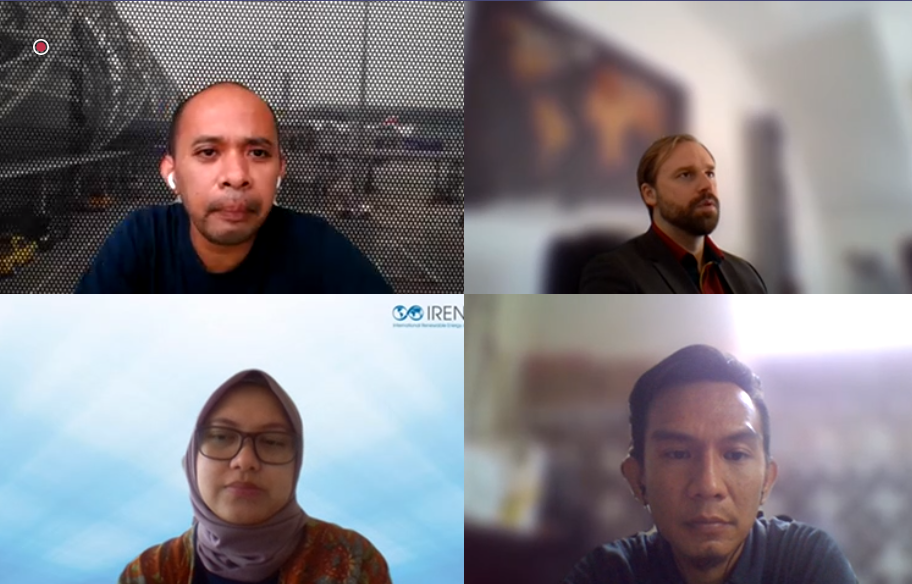Jakarta, 27 April 2021

In continuing efforts to build knowledge on energy and climate nexus, ACCEPT held the first in-house sharing session in 2021. This is This is continuation of the in-house sharing session throughout 2020. Experts from International Renewable Energy Agency (IRENA) were invited to share about World Energy Transition Outlook (WETO). The sharing session were led by ACCEPT Project Manager, Mr. Beni Suryadi.
The highlights of WETO and the importance of ASEAN Energy Transition Outlook were explained by Mr. Nicholas Wagner, IRENA Program Officer. IRENA mandated the promotion of widespread adoption and sustainable use of all forms of renewable energy. IRENA serves as centre of excellence for knowledge and innovation, global voice of renewables, network hub, and source of advice and support.
The WETO focused on global pathway to achieve the 1.5 °C climate target where the global CO2 emissions need to drop to net zero by 2050. The baseline emissions continue to rise, while the policies of governments (Planned Energy Scenario) result in flatlining emissions. The Baseline Energy Scenario projects 46.5 GtCO2 emissions by 2050 with 3-4 °C rise in global temperatures, while the Planned Energy Scenario estimates 36.5 GtCO2 emissions with around 2°C rise, and 1.5 °C Scenario sequesters 0.4 GtCO2. The steepest decline in emissions is necessary over the next 10 years, therefore 2020 must be the decade of action.
Renewables and energy efficiency and conservation dominate the focus of energy transition with 25% share each, while 20% share comes from electrification, 10% from hydrogen and its derivatives, 6% from Carbon Capture Storage (CCS) and Carbon Capture Utilisation (CCU) Industry, and 14% from Bioenergy Carbon Capture Storage (BECCS) and other carbon removal measures. The Total Primary Energy Supply (TPES) increases 31% by 2050 under current policies. Accelerated deployment of renewables, electrification, and energy efficiency results in over 22% reduction of TPES. The share of renewable energy in primary supply will need to grow from 14% in 2018 to 74% in 2050 in the 1.5 °C Scenario.
By 2050, 90% of total electricity needs will be supplied by renewables and direct-use of electricity, making up over half of final energy consumption, with another 8% coming from indirect forms such as e-fuels and hydrogen. Under PES, the electricity in TFEC will increase to around one-third by 2050. Around 58% of TFEC will need to be electricity (direct), green hydrogen and its derivatives; this will need to be combined with energy efficiency to keep energy demand slightly below today’s level. The power generation will need to triple compared to today’s level in order to reach 1.5 °C. Renewables will need to supply 90% of total electricity by 2050, up from 25% in 2018. Share of fossil fuel-based power will be greatly diminished, but natural gas will still exist and need to be combined with Carbon Dioxide Removal (CDR).
In transport, two-thirds of CO2 reductions come from electrification and hydrogen. In industry, hydrogen and electricity combined contribute to over one-quarter of emission reduction. Direct use of renewables and energy efficiency remain important in all sectors. Transportations need to be electric, and hydrogen could be used for shipping and aviation. However, aviation remains to be the hardest to abate in transport sector. Further, industry sector is the most complicated and diverse use of energy.
Carbon Dioxide Removal (CDR) will be required to meet 1.5 °C if no temporary overshoot is desired. As the future role of fossil fuel is bleak and would decline by more than 75% by 2050, what remains in use will be mostly in industry; thus, the necessity of CDR. Fossil fuel use needs to decline by more than 75% by 2050, with coal use almost entirely phased out by 2050, and most oil demand as well, leaving natural gas with demand a little over half of today’s level.
Investment in renewables, efficiency and electrification need to be scaled up. We are currently investing 2.5 trillion USD per year globally and we are heading to 3.4 trillion USD per year. For the 1.5 °C scenario, around 4.4 trillion USD per year needs to be invested. Integrated innovation for the decarbonisation of the global energy system includes finance innovation, business models and community engagement, structural changes across value chain, governance and institutional framework, market design and regulation, and technology and infrastructure. Innovation will be helpful to drive the energy transition process and decarbonise the energy sector.

(Photo caption: ASEAN Energy Transition Outlook)
The WETO were further explained by Mr. Adam. Besides the global work, IRENA also seek opportunities in the region which were supported by the detailed country reports. The regional and country reports will enhance the global outlook. IRENA is working closely with ASEAN Centre for Energy (ACE), since the upcoming ASEAN Energy Transition Outlook will adopt information from ASEAN Energy Outlook 6, ASEAN Interconnection Masterplan III, and also bioenergy assessment which has huge potential in the region. IRENA’s work on energy-climate and Nationally Determined Contributions (NDCs) were briefly introduced by Ms. Badariah Yosiana. IRENA is working on technical assistance for stronger enabling frameworks for NDC implementation plans, investment frameworks, capacity building; project pipeline development; Climate Investment Platform (CIP) and IRENA Project Facility 2.0; and investment forums.

(Photo caption: Mr. Beni Suryadi (top-left), Mr. Nicholas Wagner (top-right), Ms. Badariah Yosiana (down-left), Mr. Adam (down-right))
Discussion was held in the last session between ACE and IRENA. IRENA compares their scenario with major institutions on a global level as their efforts in benchmarking. It is known that most of the institutions are also moving forward to renewable energy, electrification, hydrogen use, etc. For the CIP, IRENA is still collecting data of potential projects to be funded later. In Southeast Asia alone, IRENA has collected around 15-20 projects.
Despite many challenges, it is possible for ASEAN to achieve the net zero emission. Mr. Nicholas explained that for the next decade, the emerging economy of ASEAN will be more oriented towards climate-friendly policies, for example the green climate fund. Indonesia could receive 200-300 billion USD to move to that direction. Thus, it is crucial for ACCEPT to support regional energy transition to achieve the 1.5 °C scenario with zero emission through the coherence between the energy and climate policies.
SNF